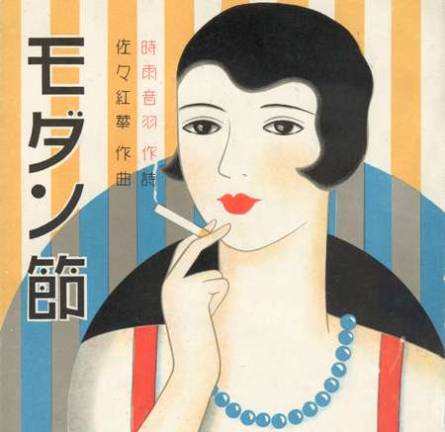By [MARSHA MCCREADIE](http://cityarts.info/author/marsha-mccreadie/) Sometimes the best way to get at a culture is to smash it up against a disparate element, or encase it in a seemingly alien time frame, seeing unexpected elements in each, even redefining each. So it is with Art Deco, and Japan, a yoking you never thought of before. No there are no Cole Porter photos, but there's a marvelous poster of three high stepping dancers worthy of the Stork Club. A vase with a single "modern" but delicate stem line of willow right down the middle, and with the traditional Japanese emblem of a cicada now highly formalized, blew me away ("Vase with Cicada and Willow Design," Katori Masahiko, 1931). All of a sudden, Japanese obsession with perfection seems congruent with Art Deco's geometrical matrix, a reaction against art nouveau. So how come we never knew about this before? For one thing, most of this 200 piece collection is from a private collection, shown through the generosity and collector perspicacity of Robert and Mary Levenson of Clearwater, Fla.?(There are also five paintings on loan from Boston's Museum of Fine Arts.) Moreover, while we always thought of pre-World War II Japan as exclusively nationalistic, not fun-filled or with an urban aesthetic, the fact is that it was rebuilding, ironically enough from today's perspective, from an earthquake. The design concept of the time? Art Deco. But let's get to the heart of the show, or rather you should get to it: The ultimate, breathtakingly beautiful images of Japanese women testing their mettle against the freedom of Western women, or the flapper concept. Watch a Japanese woman working her skis; or two in a sailboat venturing out, yet serene and contemplative in their straight-ahead gaze. Spotlight on the glamour prima donna of the exhibit: the Moga (from the Japanese "modan gaaru" or modern girl), the Japanese flapper with her lacquered red mouth, her geometrically cut hair. (It was a kick-over-the- traces era there too, with women working, living it up in public, for the first time.) See especially "Tipsy," a print by Kobayakawa Kiyoshi (1930), a Moga with a cigarette in one hand and a cocktail before her. "Deco Japan" is unquestionably the most important exhibit in New York City right now, visually stunning from its tiny objects to large paintings. It also forces us to re-think an entire nation, to re-appraise Art Deco which had its vogue from the 1960s to the 1980's when you could show off by pointing out Aztec origins and going all 30s camp. Well, the Japanese got that too, as well as the sunburst image (check out the matchbook covers), the adaptation of traditional Japanese tea screens with angular motifs of .birds looking like airplanes. Much more.
Indeed, Art Deco seems to have permeated every aspect of Japanese culture, which tells us something about the mutual attraction of hard work, discipline, and clean design lines. Deco Japan: Shaping Art and Culture, 1920-1945 is on view through June 10 at Japan Society, 333 E. 47th St.; 212-832-1155, [japansociety.org].

